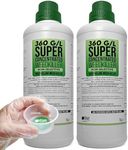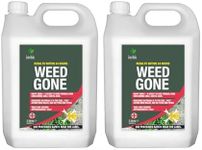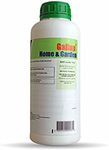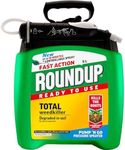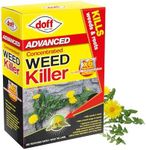Buying Guide for the Best Garden Weed Killers
Choosing the right garden weed killer can make a significant difference in maintaining a healthy and beautiful garden. It's important to understand the different types of weed killers available and how they work, so you can select the one that best fits your needs. Consider factors such as the type of weeds you are dealing with, the size of the area you need to treat, and any environmental concerns you may have. By understanding the key specifications, you can make an informed decision and keep your garden free of unwanted plants.Type of Weed KillerWeed killers come in various types, including selective, non-selective, pre-emergent, and post-emergent. Selective weed killers target specific types of weeds without harming other plants, making them ideal for lawns and gardens with mixed vegetation. Non-selective weed killers kill all plants they come into contact with, which is useful for clearing large areas or driveways. Pre-emergent weed killers prevent weeds from germinating, while post-emergent weed killers target weeds that are already growing. Choose the type based on whether you need to prevent weeds or eliminate existing ones.
Active IngredientsThe active ingredients in weed killers determine their effectiveness and safety. Common ingredients include glyphosate, 2,4-D, and dicamba. Glyphosate is a non-selective herbicide that kills most plants, while 2,4-D and dicamba are selective herbicides that target broadleaf weeds. Understanding the active ingredients helps you choose a product that is effective against the specific weeds you are dealing with and ensures it is safe for other plants in your garden. If you have pets or children, consider products with natural or less toxic ingredients.
Application MethodWeed killers can be applied in various ways, including sprays, granules, and concentrates. Sprays are easy to use and ideal for spot treatments, while granules are suitable for larger areas and provide long-lasting control. Concentrates need to be mixed with water and are often more economical for treating extensive areas. Choose the application method based on the size of the area you need to treat and your preference for ease of use. If you have a small garden, a spray might be sufficient, whereas larger areas might benefit from granules or concentrates.
Coverage AreaThe coverage area indicates how much ground a weed killer can treat. This is usually measured in square feet or acres. It's important to choose a product that matches the size of your garden or the area you need to treat. For small gardens, a product with a smaller coverage area will be sufficient, while larger gardens or extensive weed problems may require a product with a larger coverage area. Ensure you calculate the area accurately to avoid under or over-application.
Residual EffectsResidual effects refer to how long a weed killer remains active in the soil after application. Some weed killers have long-lasting effects, preventing weeds from growing for several months, while others break down quickly and require more frequent applications. If you want long-term control, choose a product with longer residual effects. However, if you plan to plant new vegetation soon after treatment, opt for a weed killer with minimal residual effects to avoid harming new plants.
Environmental ImpactThe environmental impact of a weed killer is an important consideration, especially if you are concerned about the health of your soil, water sources, and local wildlife. Some weed killers are more eco-friendly and biodegradable, while others may contain chemicals that can persist in the environment and cause harm. If environmental sustainability is a priority for you, look for products labeled as organic or natural, and avoid those with harmful chemicals. This ensures that your garden remains healthy and safe for all living things.


